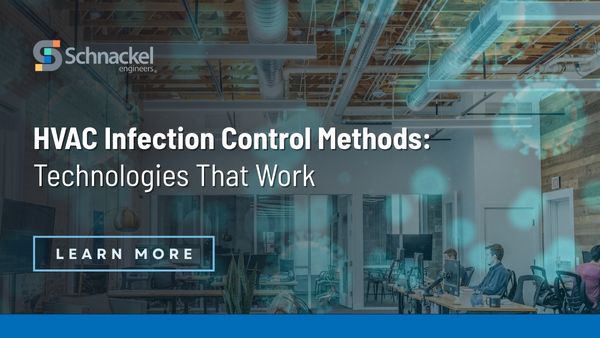HVAC Infection Control Methods: Technologies That Work

In our Indoor Air Quality 101 blog, we explored the basics of IAQ—what it is, why it matters, and how poor indoor air quality affects health, comfort, and productivity in buildings. But as we head into flu season and continue facing other airborne infectious diseases like RSV and COVID-19, building owners are asking an even more specific question: How can HVAC systems help reduce the spread of airborne illness?
That’s where HVAC infection control strategies come in. From advanced filtration to ultraviolet sterilization and fresh air ventilation, HVAC systems can play a direct role in reducing airborne pathogens. Unlike general IAQ improvements, these methods focus specifically on minimizing the risk of infection.
This blog takes a closer look at the most common HVAC infection control technologies in use today—how they work, where they’re most effective, and what to consider before implementing them.
What Is HVAC Infection Control?
HVAC infection control refers to the use of heating, ventilation, and air conditioning systems to reduce the spread of airborne pathogens in buildings. This includes strategies such as advanced air filtration, ultraviolet sterilization, increased outdoor air ventilation, and portable air-cleaning devices. Unlike general indoor air quality measures, which focus on comfort and pollutant reduction, HVAC infection control specifically targets bacteria, viruses, and other infectious particles that impact occupant health.
Most Common HVAC Infection Control Technologies
Mechanical Air Filtration
The foundation of any HVAC infection control systems is mechanical filtration. Standard air filters are already present in all commercial systems, but their effectiveness varies depending on the filter rating.
- MERV 13 and above: Filters rated at MERV 13 or higher can capture particles as small as 0.3 microns, which includes many bacteria and some virus-sized particles.
- Challenges: Higher efficiency comes at the cost of increased pressure drop across the filter. If the existing HVAC system is not designed to handle that extra resistance, it can reduce airflow, decrease efficiency, and even damage equipment.
Takeaway: Upgrading filters can improve infection control, but the system must be assessed to ensure compatibility.
Electrostatic Air Filtration
Electrostatic air filters work by charging airborne particles and collecting them on oppositely charged plates.
- Pros: They can remove very small particles that mechanical filters struggle to capture.
- Cons: Their efficiency drops quickly if the collection plates aren’t cleaned regularly. They can also generate ozone as a byproduct, which has potential health concerns and no universally accepted safe exposure level.
Takeaway: Electrostatic filters can add another layer of defense but require diligent maintenance and careful monitoring.
Germicidal Ultraviolet (UV-C) Sterilization
One of the most time-tested and reliable methods for controlling pathogens in air systems is germicidal ultraviolet (GUV) light, particularly UV-C.
- How it works: UV-C light disrupts the DNA and RNA of bacteria and viruses, inactivating them so they cannot reproduce.
- Applications: UV lamps can be installed within supply ducts, directly inside air handling units, or even in upper-room applications.
- Proven effectiveness: UV-C has been used successfully in healthcare and biotech settings for decades.
Takeaway: When properly applied, UV-C sterilization is a proven solution for reducing biological hazards in HVAC systems.
Bipolar Ionization
This technology uses high-voltage electrodes to generate reactive ions that attach to contaminants, theoretically neutralizing them.
- Potential benefits: Claims include reduced pathogens and improved IAQ.
- Concerns: Independent scientific studies remain limited. Some systems may also create ozone as a byproduct, similar to electrostatic filters.
Takeaway: While marketed heavily, bipolar ionization lacks the robust evidence base of more established methods. Building owners should weigh risks carefully before investing.
Fresh Air Ventilation
Increasing the volume of outdoor air brought into a building is one of the simplest ways to improve indoor air quality and reduce the spread of pathogens.
- Standards: Codes such as ASHRAE 62.1-2022 set minimum ventilation requirements, but going beyond these baselines can further reduce airborne contaminants.
- Tradeoffs: Bringing in more fresh air increases energy demand and can strain HVAC systems, particularly in extreme climates.
- Solutions: Energy recovery ventilators (ERVs) can offset these impacts by transferring energy between outgoing and incoming air streams. CO₂ monitoring and demand-control ventilation can also help balance energy use with IAQ needs.
Takeaway: Fresh air is essential for dilution, but it must be managed in a way that maintains comfort and efficiency.
In-Room and Portable Devices
Not all infection control happens at the system level. Portable and in-room devices provide additional flexibility, especially in high-risk environments.
- Upper-room UV-C fixtures: Mounted above 7 feet, these treat air circulating in the upper part of a room.
- Portable UV-C decontamination robots: Used for surface disinfection, though spaces must be unoccupied during use.
- Portable HEPA units: Self-contained devices effective at removing particles from the air.
- Room ionization units: Similar to bipolar ionization systems, with the same risks and limitations.
Takeaway: Portable solutions are valuable supplements but should be considered part of a layered approach rather than a standalone fix.
Choosing the Right HVAC Infection Control Strategy
Every building is different, and infection control strategies should be tailored to its purpose, occupancy, and existing HVAC capabilities. For example:
- A healthcare facility may rely on UV-C sterilization and HEPA filtration.
- An office building might see major benefits from improved MERV-rated filters and CO₂ demand controlled ventilation.
- Retail environments may combine ERVs for more fresh air with higher efficiency filtration and CO2 demand controlled ventilation.
The most effective approach is often a combination of strategies, balancing performance, safety, energy use, and long-term maintenance requirements.
Conclusion
Improving indoor air quality is essential, but infection control requires targeted strategies. The best results come from layering methods like filtration, UV sterilization, fresh air, and portable devices.
With flu season underway—and other airborne illnesses still a concern—now is the time to evaluate your HVAC systems. Proactive upgrades can protect occupants, reduce absenteeism, and keep indoor spaces safer year-round.
Ready to strengthen your building’s infection control? Contact Schnackel Engineers to explore the best HVAC strategies for your facility.
Comments